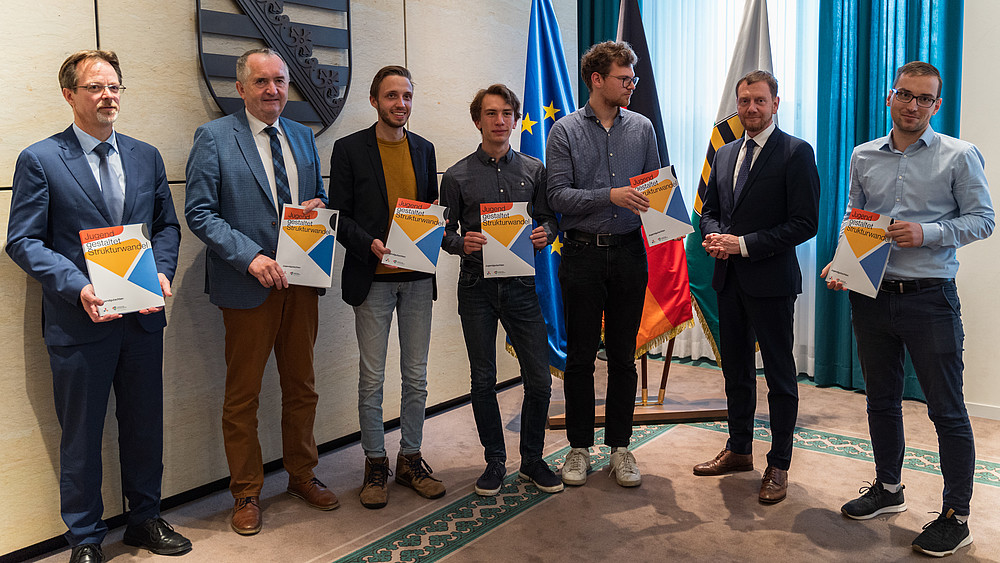HSZG students present ideas for structural change to Saxony's government.

Successful implementation of structural change requires young people with ideas and visions for their home region. HSZG students Timon Conrad and Marcus Wöckel are both among them. Together with other young people from the coal regions in East and West, they have come together to develop ideas for structural change. These included proposals such as establishing mobile doctors' surgeries in the countryside, building tiny house settlements on former opencast mining sites or, in Timon Conrad's case, developing the university campus into an "experimental laboratory for the energy transition".
The best ideas were incorporated into a "youth report" entitled "Youth shapes structural change". On October 18, the students met at the Saxon State Chancellery to present their report to Saxony's Prime Minister Michael Kretschmer.
Timon Conrad, an energy and environmental engineering student, also had the opportunity to draw attention to his project outline. His proposal is for colleges and universities in coal-mining regions to become climate-neutral and to involve research and, above all, students in this process. If, for example, they plan the calculation of a photovoltaic system, which is then also built on campus, the 23-year-old believes this would provide much greater motivation than any theoretical lessons.
The first step towards implementation has now been taken: the Saxon Minister for Regional Development, Thomas Schmidt, and the officer for structural development in Lausitz and the Leipzig region, Jörg Huntemann, showed great interest and offered the group another meeting to discuss the youth report in more detail.
The public relations department conducted an interview with Timon Conrad on the subject of "youth assessments":
Who came up with the idea for this "youth report"?
The ideas were developed at a planathon in November 2021 with other young people from the three coal mining regions. The whole thing was organized by Leuphana University as part of the German government's youth strategy.
Why did you decide to take part in the Planathon?
As a region where I was born and grew up, Lausitz is very close to my heart. I want young people to have the same or even better opportunities in the future. Be it in education, training, leisure, participation and co-determination. Above all, I would like to see co-determination structurally anchored so that everyone can actively participate in it. I am committed to this.
How did you approach the project?
I initially went into the Planathon event with a relatively open mind. I had already taken part in other events, such as 'Mission2038', which were more about smaller projects that each participant could implement. However, the Planathon was about a vision with more possibilities. That was what particularly motivated me to take part.
How did the report ultimately come about?
The "Youth Report" was written by the Planathon's youth editorial team over the course of several additional virtual meetings. The recommendations for action were worked out and the ideas revised. Many of the ideas, which are listed in the appendix of the long version and serve as the basis for the summary, came from the Planathon, which was also attended by Marcus Wöckel, who studies electrical power systems at the HSZG. The Planathon brought together around 50 young people from the three coal regions of the four federal states across Germany. Marcus Wöckel was there for the Central German coalfield and I was there for the Lausitz coalfield. Selected people then attended the handover of the report to the respective state governments. Marcus was in Saxony-Anhalt and Saxony, I was only in Saxony. The report has not yet been handed over to the federal government.
Who can support the implementation of your ideas and recommendations?
I discussed the "Youth Report" with Professors Dzienis, Kornhuber and Schmidt at our university. Together with them, I am currently trying to tackle ideas that seem feasible for the HSZG, such as the climate-neutral campus. I am in lively discussions with Lukas Müller from Görlitz, who is also involved in the HSZG's University4Future process as an external consultant. Together with Annekathrin Kluttig and Florian Reß from the climate protection management team, we are looking at how our ideas can be anchored in the university's climate protection concept. I also think the project work of Prof. Kunick and student Jonas Pfeiffer, who are currently trying to make the Görlitz campus "climate neutral" in the area of heating, is really good. In general, anyone who is interested can support us with ideas and energy.
What was it like for you in the State Chancellery when it was time for the handover?
It was nice for me to be able to talk to politicians. Above all, I was pleased that there was another appointment, that we were able to go through the ideas step by step and not just hand over the report itself.
Click here for the visions for the coal regions: The youth report "Youth shapes structural change".
More information:
Timon Conrad
E-Mail: Timon.Conrad(at)stud.hszg.de